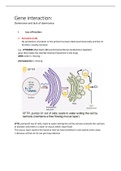Neomorphic Study guides, Revision notes & Summaries
Looking for the best study guides, study notes and summaries about Neomorphic? On this page you'll find 7 study documents about Neomorphic.
All 7 results
Sort by
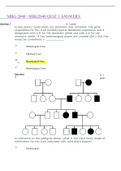
-
MBG 2040QUIZ 1 ANSWERS.
- Exam (elaborations) • 20 pages • 2022
- Available in package deal
-
- £13.17
- + learn more
MBG 2040 / MBG2040 QUIZ 1 ANSWERS Question 1 0 / 1 point In pea plants round seeds are dominant over wrinkled. The gene responsible for this trait exhibits typical Mendelian expression and is designated with a D for the dominant allele and with a d for the recessive allele. If two heterozygote plants are crossed (Dd x Dd) this would be considered a _ . Homozygous Cross Dihybrid Cross Heterozygous Cross Question 2 0 / 1 point In reference to the pedigree above, what ...
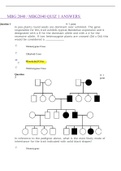
-
MBG 2040 / MBG2040 QUIZ 1 ANSWERS
- Exam (elaborations) • 20 pages • 2022
- Available in package deal
-
- £12.76
- + learn more
MBG 2040 / MBG2040 QUIZ 1 ANSWERS Question 1 0 / 1 point In pea plants round seeds are dominant over wrinkled. The gene responsible for this trait exhibits typical Mendelian expression and is designated with a D for the dominant allele and with a d for the recessive allele. If two heterozygote plants are crossed (Dd x Dd) this would be considered a _ . Homozygous Cross Dihybrid Cross Heterozygous Cross Question 2 0 / 1 point In reference to the pedigree above, what ...

-
5. You are studying a mutation in mice, which acts dominantly. Mice t
- Exam (elaborations) • 1 pages • 2023
-
- £5.73
- + learn more
5. You are studying a mutation in mice, which acts dominantly. Mice that have only one copy of the allele carrying this mutation have a kinky tail phenotype You identify the gene that the mutation affects and find that the codon that encodes the second amino acid in the predicted protein has been mutated to a stop codon. Would you characterize this mutation as a loss-of- function or a gain- of-function and what specific subtype (hypermorphic, antimorphic, etc. ) within these categories? Exp...
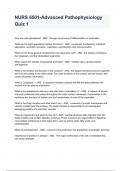
-
NURS 6501-Advanced Pathophysiology Quiz 1
- Exam (elaborations) • 10 pages • 2024
-
- £6.58
- + learn more
NURS 6501-Advanced Pathophysiology Quiz 1 How are cells specialized? - ANS through the process of differentiation or maturation What are the eight specialized cellular functions? - ANS movement, conductivity, metabolic absorption, secretion, excretion, respiration, reproduction, and communication What are the three general components of an eukaryotic cell? - ANS the plasma membrane, the cytoplasm, and the intracellular organelles. What causes the release of lysosomal enzeme...
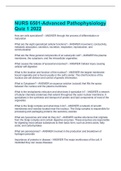
-
NURS 6501-Advanced Pathophysiology Quiz 1 (solved)
- Exam (elaborations) • 10 pages • 2022
-
- £7.73
- + learn more
How are cells specialized? - ANSWER through the process of differentiation or maturation What are the eight specialized cellular functions? - ANSWER movement, conductivity, metabolic absorption, secretion, excretion, respiration, reproduction, and communication What are the three general components of an eukaryotic cell? - ANSWER the plasma membrane, the cytoplasm, and the intracellular organelles. What causes the release of lysosomal enzemes? - ANSWER Cellular injury causing cellular s...
Description of loss of function and gain of function alleles with main examples. Explanation of incomplete dominance and codominance
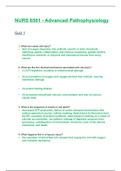
-
NURS6501 / NURS 6501: Advanced Pathophysiology Review Quiz 1 (Latest 2020 / 2021)
- Exam (elaborations) • 17 pages • 2020
-
- £9.32
- + learn more
NURS 6501 - Advanced Pathophysiology Quiz 1 1. What can cause cell injury? - lack of oxygen (hypoxia), free radicals, caustic or toxic chemicals, infectious agents, inflammatory and immune responses, genetic factors, insufficient nutrients, or physical and mechanical trauma from many causes 2. What are the four biochemical themes associated with cell injury? - (1) ATP depletion, resulting in mitochondrial damage - (2) accumulation of oxygen and oxygen-derived free radicals, causing membrane...

Did you know that on average a seller on Stuvia earns £76 per month selling revision notes? Hmm, hint, hint. Discover all about earning on Stuvia



